SMS Marketing Done Right: 3 Ecommerce Brands to Learn From
These 3 brands found a way to use text messaging to send customers the right message at the right time without annoying them. Here's how they did it.

Written by Daniel J. Murphy
Imagine you’ve just had a long day at work. You’re finally at home, eating your dinner, when a call comes in. You answer it, only to find that it’s a telemarketer. Annoyed, you ask the caller to please take your number off their list.
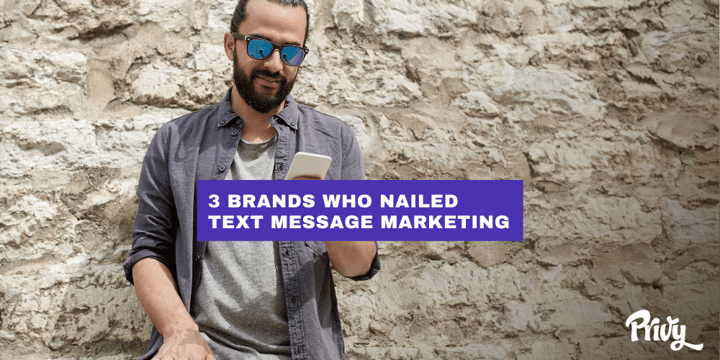
Now imagine the same scenario, but instead, your phone buzzes with a text. It’s a message from your favorite clothing brand, with a few product recommendations.
You won’t read it now, but you plan to look at the message after dinner.
Nobody wants a call from a business, but getting a text from a brand is different.
You’re in control of when you respond. And because brands are able to do quite a bit through text—send links, complete orders, and more—you may find that the message is pretty useful.
Get our best content on ecommerce marketing in your inbox 2 times a week
Customers like this type of communication. According to Conversmart data, 79% of Americans want to hear from their favorite brands over text.
And if they receive a message from a brand, they’re likely to open it: Shift Communications reports that 82% of people open every text they receive.
But that doesn’t mean shoppers want dozens of spammy texts. Just like any other customer communication, your texts won’t be received well by shoppers unless your messages provide value.
See for yourself with these three ecommerce texting campaigns. These brands saw positive results—whether that was increasing brand awareness or revenue—because their texts were useful to shoppers, well timed, and tied to the brand’s products.
LensDirect: Encourages repeat purchases with text reminders
Just because a customer hasn’t reordered a product doesn’t mean they aren’t interested. For all you know, they were seconds away from clicking “complete order” when a Facebook notification pulled them away.
Nudge these shoppers with a text reminder, like the contact-lens retailer LensDirect. The brand texts their shoppers when their contacts supply is about to run out and they need to reorder.
LensDirect initially used email to send reorder reminders, but their messages saw only a .18% conversion rate.
Once they switched to text, that conversion rate jumped to 2.12%—an increase of over 1,000%. “That percent change on that conversion rate led to an order percent change of 840%,” said Rob Reynolds, LensDirect’s VP of technology.
One reason could be that texting is more convenient than email, in which customers would have to click a link and be redirected to a new page.
With a text reminder, the customer can instantly reorder right from the text thread.
Also, the message is well-timed. LensDirect texts the reminder only when customers need new contacts most: just as their supply is about to run out. If the company sent texts throughout the month, the campaign would probably annoy customers.
And, importantly, LensDirect is reminding shoppers about a product they’ve bought before.
If they were asking customers to order an unrelated product—one that didn’t match their purchasing history at all—the texts would probably come off as pushy sales attempts. Instead, they remind shoppers to order a product they know they need, so the message is genuinely helpful.

Takeaway: Remind shoppers about the products they like
LensDirect is in a unique spot. Contacts are something their shoppers have to replace, so the brand’s text reminders are especially apt. If you don’t sell a consumable product, you might second guess whether customers will be receptive to reminder texts from your company.
Don’t be so sure. The larger lesson behind LensDirect’s campaign is that shoppers are open to text reminders about products they’ve shown interest in.
If your customer adds an item to their cart, they won’t be surprised when your company messages them about the product. Best case scenario, they’ll be happy you sent the text and place an order right away.
How might you do that through text? Send an abandoned-cart message to remind shoppers they left a few items behind.
Like LensDirect’s reminder, an abandoned-cart text is a relevant reminder for shoppers. They were about to buy something from you and may have forgotten to complete the purchase. Nudge them to finalize the order with a text.
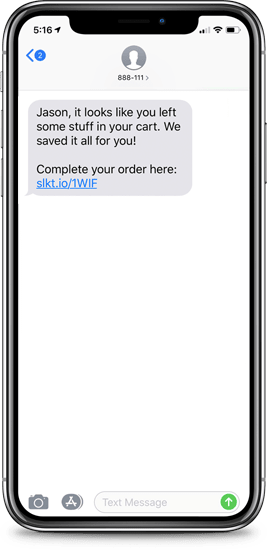
310 Nutrition: Drives upsells with product-recommendation texts
Think about the last time you ordered a McDonald’s burger. The cashier probably asked, “Would you like fries with that?” It’s a classic postpurchase upsell.
McDonald’s knows that if you’re in the mindset of buying a burger, there’s a good chance you’ll be in the mood for a side of fries, too.
The meal-replacement-shake company 310 Nutrition uses the same tactic.
Once a customer purchases a set of shakes, 310 texts the customer about other flavors they can add to their order before it’s processed.
Many of 310’s shoppers upgrade their order after getting the message. The company reports that this upselling campaign via text generates over $100,000 in weekly revenue.
Timing is a big factor in this campaign’s success. 310 sends the upsell message right after an order is placed, so the customer is already in a purchasing mindset.
It’s also critical that 310 suggests relevant products to add to the order. With a (recent) history of ordering 310 shakes, there’s a good chance the customer will want to try the brand’s other flavors.
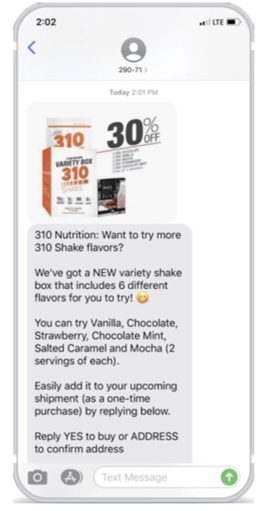
Takeaway: Recommend products based on past purchases
A product suggestion isn’t something you should send lightly. If it appears out of the blue, it probably won’t lead to an order. Even worse, there’s a good chance your unprompted sales text will lower shoppers’ trust in your brand.
310’s upsell works because the recommendation is well timed and appropriate for their customers.
With that said, their campaign isn’t easy for a small business to execute. It requires a full tech stack—including a subscription software, an upsell software, and more.
For a similar campaign, text product suggestion messages that just include item links, not ordering functionality.
Text shoppers these recommendations right after they make a purchase so they’re still in a buying mood.
And only recommend products that are similar to their past orders. If you help shoppers find items like the ones they already love, they’ll be happy you sent the message.
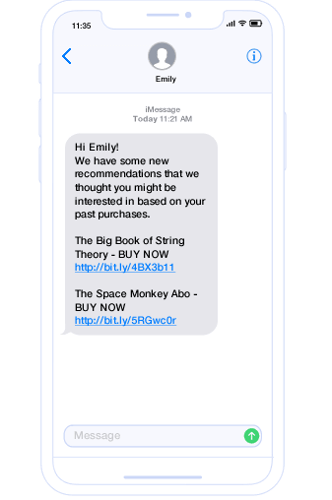
Equal Parts: Boosts brand awareness with text replies from real people
A great text marketing campaign doesn’t need a product mention. Valuable, educational content is enough to build interest in your brand, as the cookware company Equal Parts shows.
The company offers a free text-a-chef service where culinary experts text cooking tips and recipes to shoppers. Anyone can opt in, Equal Parts customer or not.
The chefs are available to text five days a week during prime grocery shopping hours.
If subscribers don’t text, the chefs will check in to see whether they can help with meal prep, food recommendations, ingredient questions, and more.
This text-a-chef program has helped Equal Parts build excitement around their brand. The company’s Instagram video about the service received nearly 1.4K views—a particularly high number of views for the brand, especially considering that their account only has 11K followers.
[Source]
People especially love how they’re able to get the cooking resources they need in one place. “It’s been nice not having to sift through so many search results and videos to get my questions answered,” said Chloe, a text-a-chef user.
The traction Equal Parts is seeing around text-a-chef, after launching the program just this past September, is huge for the brand.
It’s the perfect resource to attract their target audience: the beginner cook who doesn’t want a fussy kitchen setup and doubts their culinary skills.
“To make cooking more accessible to a generation that doesn’t think they have the time, motivation, or techniques, we’re offering a model that’s equal parts cookware and guidance,” the company said in their "Introducing Equal Parts" blog post.
Just as Equal Parts customers want convenient cookware, they’re also looking for cooking guidance that simplifies their time in the kitchen.
The culinary experts running text-a-chef never promote Equal Parts’ cookware, but it’s easy to see how the resource could lead to purchases. For people who haven’t bought EP cookware yet, text-a-chef builds their trust and curiosity around their products. If this company is willing to provide free access to culinary experts, they think, their products must be thoughtful and customer-centric.
As for existing EP customers, they’re going to regularly use the brand’s cookware if they’re following suggestions from text-a-chef.
And if they’re constantly getting value out of the products, they’re more likely to make a repeat purchase and spread the word about Equal Parts.
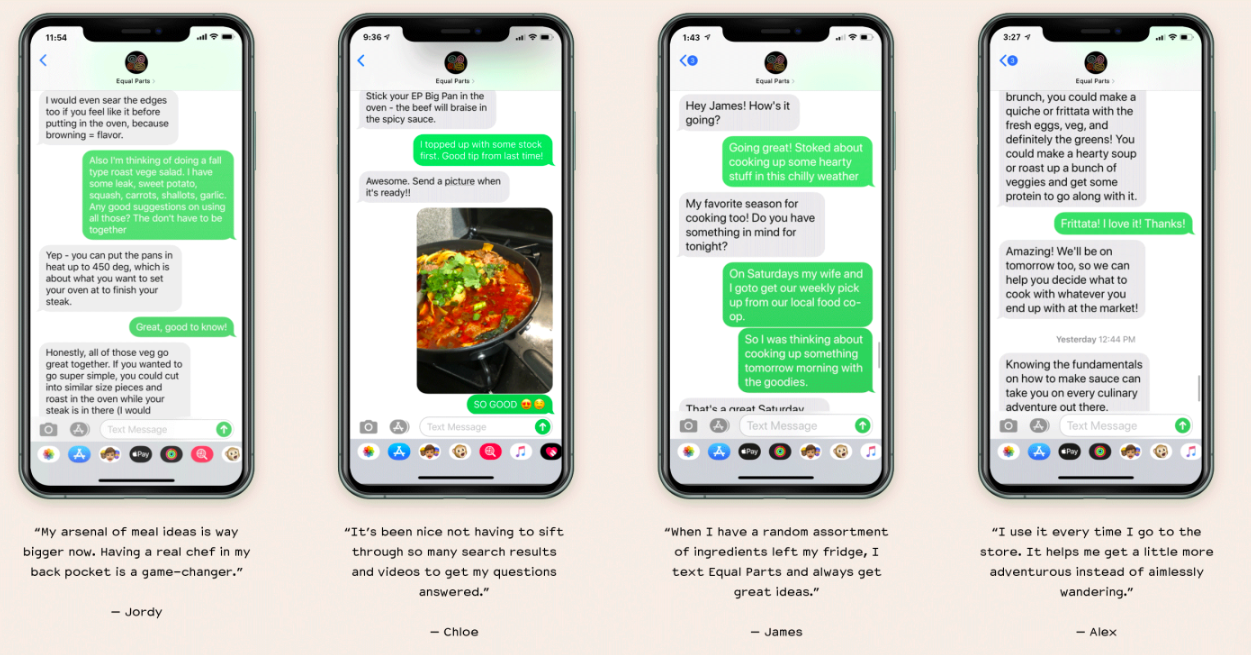
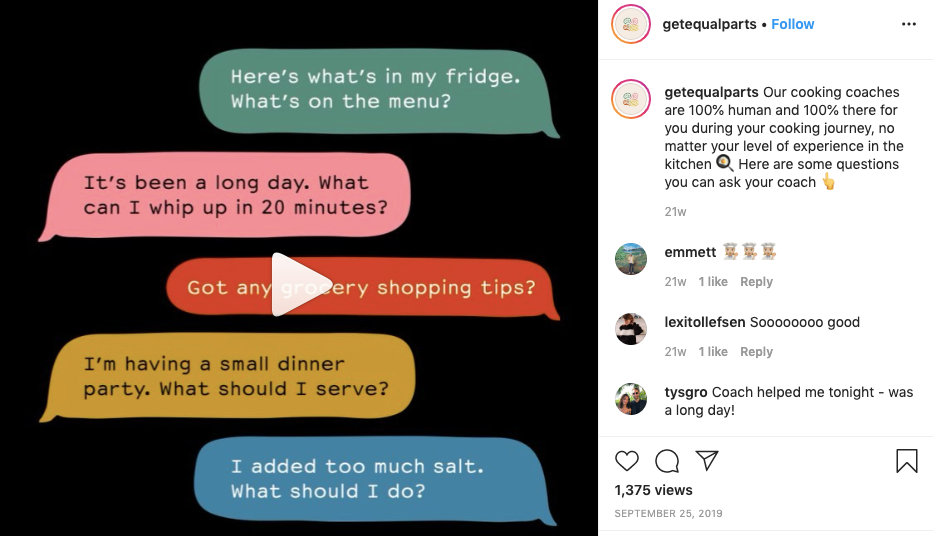
Takeaway: Give quick, reliable access to educational resources
It can feel reckless to invest in marketing that isn’t about your product. Why put so much time and money into a campaign that isn’t even plugging what you’re selling?
Equal Parts shows that creating educational resources for your entire audience, customers or not, is worthwhile.
While many companies use chatbots, EP pays professional chefs to speak with shoppers for the majority of the week.
Sure, it’s a major investment, but it goes a long way toward building people’s awareness, trust, and appreciation for the brand.
Most small businesses aren’t in a position to set up an in-person texting service—and that’s okay. You can still connect with your audience by occasionally texting product-related tips to shoppers.
[Source]
If you’re an apparel brand, message customers about an unlikely way to use a scarf. Sell plants? Text shoppers your number one tip for maintaining succulents.
Offer useful advice that’s aligned with your brand but not directly about your products. Your willingness to share knowledge, just for the sake of it, won’t go unnoticed by your audience.
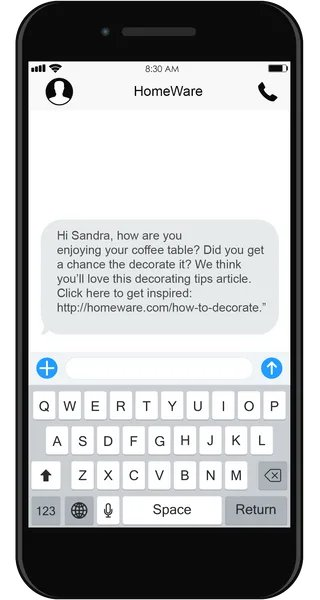
Boost brand loyalty by texting customers
You can’t sustain a business without repeat purchases. The key to having customers who keep coming back? Be everywhere your shoppers are so you’re always able to connect with them. And in 2020, that means texting them.
People are constantly reading and responding to texts, so you’re able to build relationships at a lightning pace.
Follow the example of the three brands in this post, and use text to help shoppers complete tasks in seconds—whether that’s placing an order or finding the next product they need.
Don’t worry about annoying people. If your texts are useful and customer-oriented, it’s more likely that the shoppers you message will thank you with their brand loyalty.
Writen by Daniel J. Murphy

Dan is a B2B marketing leader with over 7 years of experience helping SaaS startups grow. Before joining Privy, Dan was the Director of Product Marketing at Drift. He’s also worked in demand generation, brand marketing and marketing ops. Dan loves to geek out over marketing strategies and technology. He co-authored “This Won’t Scale” with Privy’s CMO, Dave Gerhardt at their previous company.
You may also like to read
Learn how we responsibly build, test, and refine AI models and capabilities to ensure accuracy and domain relevancy.
What To Offer In A Cart Recovery Campaign: 9 Secrets For Turning Browsers Into Buyers
70% of online shoppers abandon their carts for one reason or another. But these 9 secrets will teach you what to offer in a cart recovery campaign.
How to Create an Abandoned Cart Flow That Actually Converts
Proven Copy, Timing, and Incentive Ideas
5 Website Popup Mistakes Killing Your Conversions (And How to Fix Them)
Popups still work, but avoid these mistakes to make the most of them.
